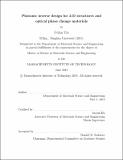Photonic inverse design for 3-D structures and optical phase change materials
Author(s)
Yin, Gufan.
Download1119388701-MIT.pdf (1.738Mb)
Other Contributors
Massachusetts Institute of Technology. Department of Materials Science and Engineering.
Advisor
Juejun Hu.
Terms of use
Metadata
Show full item recordAbstract
Advances in materials science and photonic device fabrication techniques have provided great potential for making better photonic devices. For example, 3-D photonic structures can be fabricated, and optical phase change materials can been utilized to make non-volatile reconfigurable multi-state optical components. These advances call for better design methods to fully exploit their potential. Traditional photonic design methods are inefficient for exploring the full design space because many physical simulations are required and the physical simulations are very time-consuming. Photonic inverse design methods can explore the full design space more efficiently by using the gradient information at the cost of only two physical simulations per iteration. In this thesis, photonic inverse design algorithms based on the adjoint-variable method have been developed for 3-D structures and optical phase change materials. Ultra-compact waveguide polarization converters with 3-D structures and ultra-compact waveguide switches with optical phase change materials have been designed using such algorithms. Both types of devices have ultra-small footprint and can be designed starting from very simple initial structures. After several hours of optimization, the devices will usually exhibit good performance including low insertion loss and high extinction ratio.
Description
This electronic version was submitted by the student author. The certified thesis is available in the Institute Archives and Special Collections. Thesis: S.M., Massachusetts Institute of Technology, Department of Materials Science and Engineering, 2019 Cataloged from student-submitted PDF version of thesis. Includes bibliographical references (pages 79-85).
Date issued
2019Department
Massachusetts Institute of Technology. Department of Materials Science and EngineeringPublisher
Massachusetts Institute of Technology
Keywords
Materials Science and Engineering.